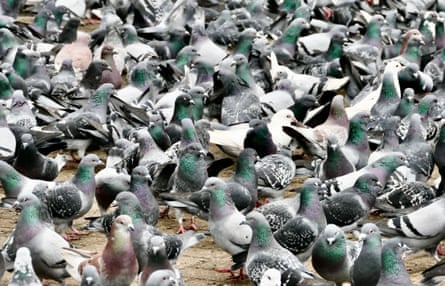Multiple waves of avian influenza have left a trail of devastation across the globe, leading to the deaths and culling of more than 300 million chickens, ducks and geese and an unknown number of wild birds between 2005 and 2021.
Today, with parts of Europe and North America in the midst of the worst outbreak on record, a global cohort of researchers is keeping cautious watch amid concerns about the impact the disease could have on humans.
“There is concern about it having pandemic potential,” says Wendy Blay Puryear, a molecular virologist at Tufts University. “Before Covid was on anybody’s radar, this was the one that we were all watching very closely.”
The virus is currently considered a low risk to humans, she says. “But anything that has the ability to replicate and evolve rapidly, and anything that has that ability to infect a lot of different hosts is kind of on borrowed time.”
Much of the focus of experts is on H5N1, a highly pathogenic avian influenza that has fuelled, in part, the surge in cases around the world. First identified at a goose farm in Guangdong, China in 1996, the virus has turned up in at least 63 species of wild birds and has shown itself capable of infecting mammals such as bobcats, harbour seals and bears.
The more the virus spreads, the greater the chances are that it may spill over into humans, says Thijs Kuiken, a professor in the department of viroscience at Erasmus University Medical Centre in Rotterdam. Once the virus infects humans, the concern is that it could further adapt to allow human-to-human transmission.
“The chance of this happening is very small, but the impact – if it does happen – is very big, because it means that we then have a new influenza pandemic,” he says, pointing to the 1918 flu, believed to have killed as many as 50 million people, as an example of a pandemic that has been linked to an avian influenza and originating in birds.

As H5N1 crisscrosses the globe, its impact on humans has set off alarms; between 2003 and October 2022, the virus turned up in 865 humans in 21 countries, resulting in 456 deaths. While the cases – most of them in Africa and Asia – were linked to the handling of infected live poultry rather than human-to-human transmission, the figures suggest the virus “has a high case fatality rate in people who become infected”, says Kuiken.
Public health officials are taking few chances. In the UK, where a duck breeder tested positive for the virus in late 2021 after handling infected poultry, the Health Security Agency has been working to develop an “off the shelf exercise” to prepare for an outbreak of avian flu among humans, the UKHSA told the Guardian in an email.
In the Canadian province of British Columbia, public health officials recently warned doctors to watch out for avian flu infections among patients, after a spike in cases among poultry at local farms.
The virus would probably require more than one or two changes to enable human-to-human transmission, says Ian Barr, the deputy director of the WHO’s Collaborating Centre for Reference and Research on Influenza in Melbourne.
“We never really know with these viruses … but they’ve been with us for 18 years in various forms and they haven’t yet gained that function of being easily transmissible to man,” says Barr. “So, hopefully the virus finds that a difficult thing to do, but it’s something which we’re not entirely knowledgable about.”
He described it as a game of numbers. “The more viruses that are out there, the more species that they infect, the longer they hang around for, then the more chance there is for something to mutate or go awry or reassort with an unwanted consequence.”
after newsletter promotion

Efforts to halt the spread of this strain of virus have been complicated by its prevalence in wild birds, says Rebecca Poulson of the College of Veterinary Medicine at the University of Georgia.
“We know birds move incredibly long distances,” she says. “And if these birds are infected and are shedding these viruses as they move across the landscape, they can disseminate it quite far and wide in a really short amount of time.”
The presence of the virus in wild birds and farmed poultry has allowed it to ping-pong between populations and amplify its spread, says Nichola J Hill, an assistant professor of biology at the University of Massachusetts in Boston.
“I think we used to cling to this idea that we can control the virus in poultry, we’re set, no problem,” she says. “And now we’re facing a new era because if it has become established in wild birds, that’s a far more complex situation in terms of figuring out how to control it and predict where it will go next.”
What is clear, however, is the role our food system has played in getting us to this point, she says, citing the high densities of poultry seen in commercial farming and the genetic similarity of most of the animals. “All of these amount to a situation which is ripe for the virus to get a foothold and then evolve towards virulence.”
